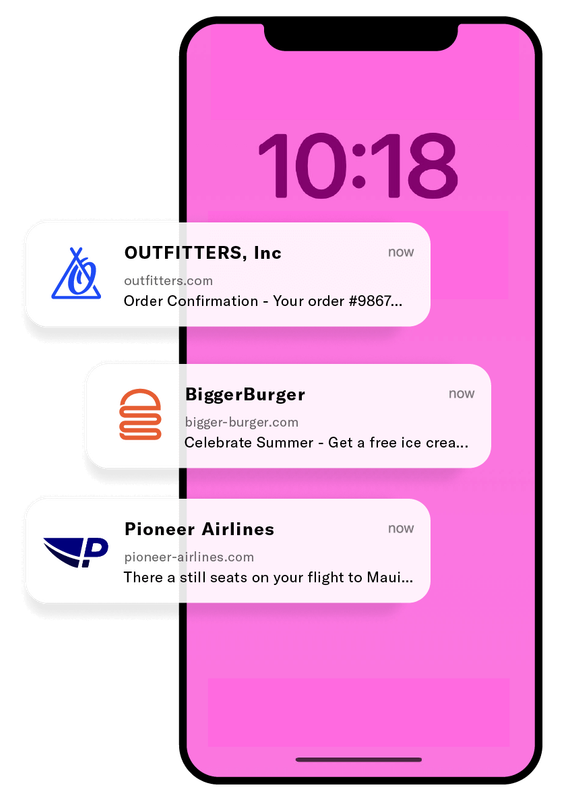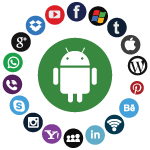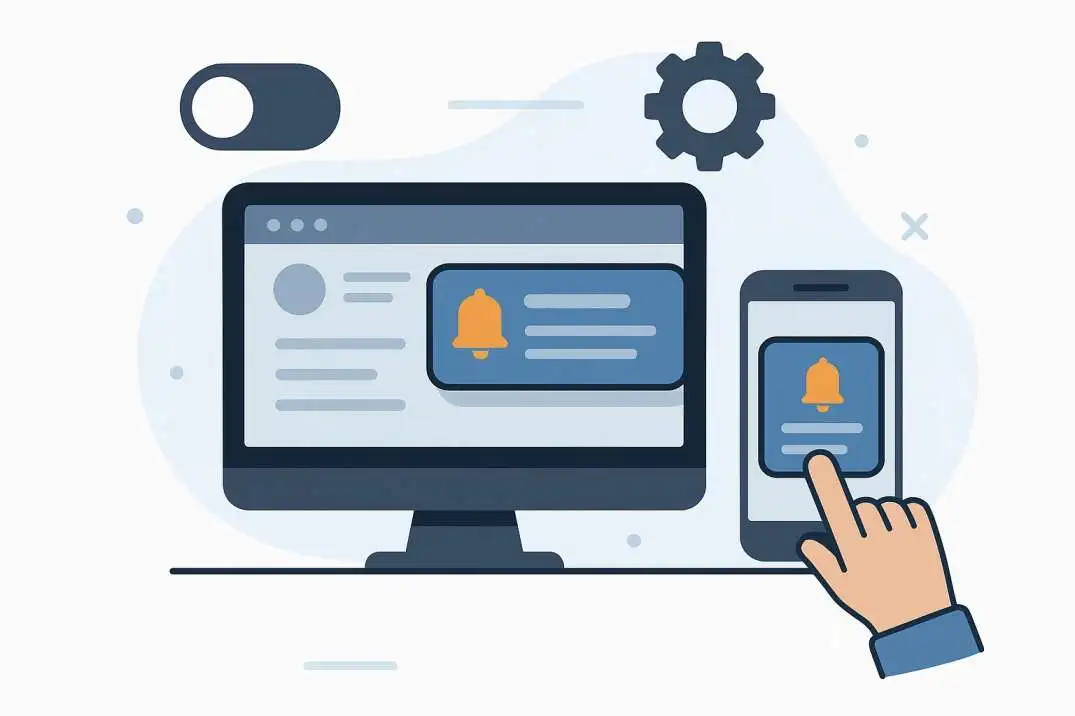In today’s fast-moving digital world, user engagement is everything. You might have a great app or a well-designed website, but if users don’t come back, it won’t matter.
This is where Push notification marketing come into play. They help you connect with your users in real-time and bring them back with timely messages, offers, updates, and more.
But how do you set up Push notification marketing without getting too technical? Whether you run a website, an Android app, or an iOS app, this guide will walk you through the essentials of setting up push notifications from scratch.
How to Set Up Push Notifications on Your Website or App?

When critical, time-sensitive occasions happen, advise your site clients with thrust notices you send from your server. To do this, include bolster for web thrust — thrust notices that utilize the cross-browser.
Thrust API, Notices API, Badging API, and Benefit Specialist measures. For more data on these measures, see the W3C report on Thrust API guidelines. Include web thrust to Domestic Screen web apps in iOS 16.4 or afterward and Webpages in Safari 16 for macOS 13 or later.
Related Article: The Future of Mobile Marketing: Insights for 2023
To send web thrust notices, upgrade your webpage to subscribe clients and handle notices, and overhaul your server to send thrust notices.
If you’re as of now sending thrust notices with web thrust for other browsers, affirm that your server fulfills Safari’s prerequisites so that your existing usage works for webpages in macOS Safari and web apps. You don’t require to connect the Apple Designer Program to send web thrust notifications.
If you’re as of now sending thrust notices to clients in Safari 15 or prior utilizing Safari Thrust Notices, proceed sending thrust notices to those clients. For more data approximately best hones whereas sending a thrust notice with APNs, see Sending notice demands to APNs.
What Are Push Notifications?

Push notifications are short messages that pop up on a user’s device, even when they’re not using your website or app. They can include:
-
Reminders
-
Promotions or discounts
-
Breaking news
-
Order updates
-
Event alerts
Unlike emails or SMS, Push notification marketing appear directly on a user's screen, making them one of the most effective tools to grab attention.
Benefits of Using Push Notifications
Before we dive into the setup process, let’s take a quick look at why push notifications are worth your time:
-
Increased engagement: Notifications prompt users to return to your platform.
-
Instant communication: Deliver messages in real-time.
-
Personalization: Send tailored messages based on user behavior or preferences.
-
Cost-effective: No per-message cost like SMS.
Step-by-Step Guide to Set Up Push Notifications
1. Choose Your Platform
First, decide where you want to send push notifications:
-
Web browsers (Chrome, Firefox, Safari)
-
Android mobile apps
-
iOS apps
Each platform has slightly different methods, so you’ll need to tailor your approach accordingly.
2. Select a Push Notification Service
Instead of building your own system from scratch, consider using a third-party push notification service. Here are some popular ones:
-
OneSignal
-
Firebase Cloud Messaging (FCM) by Google
-
Pusher
-
Airship
-
Webpushr
These services offer SDKs (software development kits), dashboards, and analytics to simplify setup and tracking.
3. Set Up Push Notifications on a Website
To enable push notifications on a website, follow these steps:
a. Add an HTTPS Certificate
Browsers only allow Push notification marketing on secure (HTTPS) websites. Make sure your domain has an SSL certificate.
b. Integrate a Push Library or SDK
Choose your push service and integrate it. For example, with OneSignal, you’ll need to:
-
Sign up and create an app on the OneSignal dashboard.
-
Add a JavaScript SDK to your website.
-
Place a
service-worker.jsfile in your root directory. -
Customize the opt-in prompt (when and how users are asked to allow notifications).
c. Request Permission from Users
Use the browser’s Notification.requestPermission() function to ask users to subscribe.
Notification.requestPermission().then(function(result) {
if (result === 'granted') {
console.log('Permission granted');
}
});
d. Send Notifications
Once users have subscribed, you can send push messages via the dashboard or using an API.
4. Set Up Push Notifications for Mobile Apps
a. Android (Using FCM)
-
Go to the Firebase Console.
-
Create a new project and add your Android app.
-
Download the
google-services.jsonfile and place it in your app’s root directory. -
Add Firebase SDK to your
build.gradlefile. -
Use FCM APIs to send push messages from your server or Firebase dashboard.
b. iOS (Using Apple Push Notification Service - APNs)
-
Set up an App ID and enable push notifications in your Apple Developer account.
-
Create a push certificate and upload it to your push service (like OneSignal or Firebase).
-
Configure your Xcode project to use the correct capabilities.
-
Request permission in your app using Swift:
UNUserNotificationCenter.current().requestAuthorization(options: [.alert, .sound, .badge]) {
(granted, error) in
if granted {
DispatchQueue.main.async {
UIApplication.shared.registerForRemoteNotifications()
}
}
}
5. Customize and Schedule Notifications
Now that the system is set up, the next step is to make your messages effective:
-
Keep them short: Users quickly scan these messages.
-
Use emojis wisely: They help catch attention but don't overdo it.
-
Personalize content: Include user names, interests, or locations.
-
Test timing: Don’t send notifications too early or too late in the day.
-
A/B test: Try different titles or call-to-actions to see what works best.
Best Practices to Follow
-
Don’t spam: Send notifications in moderation to avoid annoying users.
-
Offer value: Make sure every message has a purpose—whether it's saving money, offering info, or reminding users.
-
Allow easy opt-out: Respect users' privacy and allow them to unsubscribe easily.
-
Use analytics: Monitor open rates, click-through rates, and conversions to improve your strategy.
Common Mistakes to Avoid
-
Sending too many messages
-
Not segmenting your audience
-
Using vague or generic messages
-
Ignoring time zones
-
Forgetting to test on different devices
Conclusion
Setting up push notifications for your website or app might seem technical at first, but modern tools have made it incredibly straightforward. With the right setup and strategy, push notifications can help you retain users, boost engagement, and increase conversions. What Email Will Eras Residency Interview Notification Send From?
Start small—test one platform, monitor results, and scale from there. Most importantly, focus on delivering real value through every notification you send. When done right, push notifications can become one of the most powerful tools in your digital marketing toolkit.
FAQ's- Push Notification Marketing
What are thrust notices in marketing?
Similar to mail showcasing, thrust notices permit businesses to section and personalize their messages depending on users' area, sexual orientation, or substance they've already seen, such as blogs and item landing pages.
What is the thrust procedure in marketing?
A Thrust Promoting Methodology too called thrust limited time methodology, where businesses endeavor to take their items to the clients. In a Thrust promoting procedure, the objective is to utilize different showcasing strategies or channels to 'Push' their items in arrange to be seen by the customers beginning at the point of purchase.
How viable are thrust notifications?
Push notices are an easy-to-understand strategy of contact, which can lead to a smoother client encounter, expanded maintenance, and more proficient client communication
Is SEO thrust or drag marketing?
Search motor optimization (SEO) is for the most part considered a drag showcasing technique. Curating your site or substance with pertinent watchwords, inside connecting, and a streamlined client involvement can construct your brand perceivability when clients are looking online—so that you can drag them onto your website.
What is a great CTR for thrust notifications?
For illustration, the thrust notice click-through rate (CTR) is a key marker of intrigued. Whereas the normal thrust notice CTR floats around 4.6% on Android and 3.4% on iOS*, top-performing brands regularly surpass these by refining their techniques with information.

